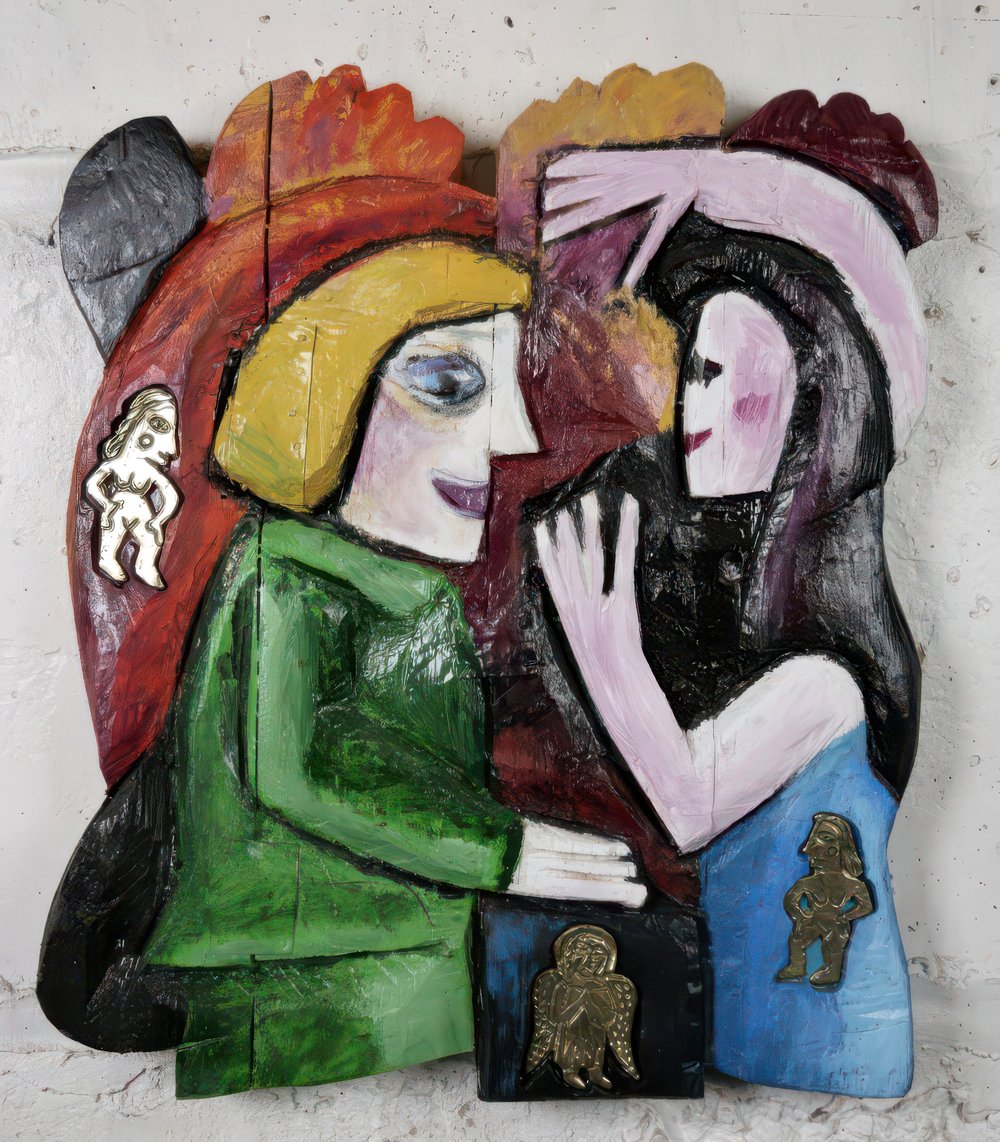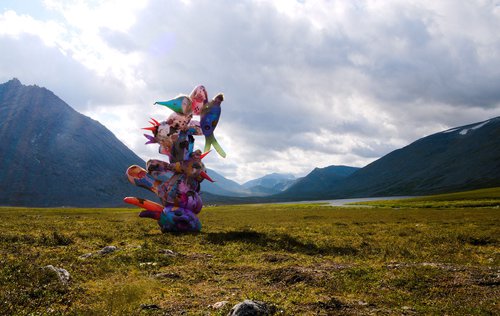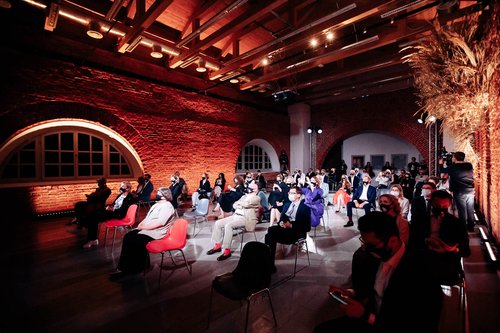Bridges Between Art and Life in St Petersburg

Sergey Gorshkov. Dance. Courtesy of Marina Gisich Gallery
Two exhibitions in St Petersburg illustrate rarely seen parent-child artistic collaborations which bridge generational gaps through shared creativity with a unique mutual understanding between established and mid-career contemporary artists.
Artistic dynasties lie at the heart of two fascinating exhibitions currently open to the public in St Petersburg. There is mother and daughter show ‘Dialogues’ with Natalia Pershina-Kalliopina (b. 1938) and Natalia Pershina-Yakimanskaya (b. 1969), aka Gluklya; and father and son Sergey Gorshkov (b. 1958) and Ivan Gorshkov (b. 1986) in ‘Gorshkov²’. Today it may seem as though the children of artists receive more public attention on the art scene than their more established parents, as the former are courted actively by galleries, collectors and critics. A status quo that is hard to redress, these two concurrent shows a drop in the ocean of generational imbalance.
Exhibiting and collaborating together with your kith and kin is about as personal as it gets in the art world. Gluklya writes in their exhibition text: “The starting point of this message is care for and admiration of my own mother, who maintains courage in a context where, it would seem, there is no longer any place for it.”. Sergey Gorshkov’s son Ivan could well have said the same, in an interview he said his father is “the only understanding person I know”. On the face of it these two shows are totally different, yet they are deeply connected for the way they reveal a special connection between those closest of all family ties, the relationship between parent and child.
St Petersburg artist Natalia Pershina-Kalliopina is now 86 years old. She graduated from the Art and Industry College, now called the Stieglitz Academy, as a textile artist and during the Soviet era created decorative, applied art for public spaces. In ‘Dialogues’ there are watercolours and fabrics by her which have never been seen in public before. Her daughter who has long been living in Western Europe co-founded ‘Factory of Found Clothes’ with Olga Egorova (b. 1968), nicknamed ‘Tsaplya’. The pair went on to become one of the most interesting art duos in St Petersburg during the 1990s and early 2000s. Their original feminist poetics included making art out of second-hand clothing, which they used as a medium to narrate personal stories, where they elevated ideas of love and trauma to the level of philosophical generalizations. The exhibition includes an object made by Gluklya called ‘Open Book’, which she describes thus: “A book with empty pages, sewn onto a waistcoat found in a Romanian vintage shop in Amsterdam, means that we tend to project any fantasies and assumptions whilst communicating with another person and filling the blank pages of their personality with our own content”.
Gluklya refers to her mother’s textiles as being “sometimes separations, sometimes bridges between art and life”. In the show they are displayed in special constructions made by Gluklya evocative of her Factory of Found Clothes. Natalia Pershina-Kalliopina's poetic and freely painted watercolours from her ‘Joy of the Dacha’ series of the late 1960s and subsequent decades exude the sense of renewal which people felt in the Soviet sixties which in part explain her daughter’s sympathetic feelings towards socialism as an ideal of universal equality and fraternity. Gluklya, who graduated from the same art college as her mother managed to “overcome an academic education, radically breaking with the conventional canon and unlearning to draw” and found her own mode of personal expression in her watercolours.
“Between ourselves we invented the names Calliope and Gluklya so we could be friends and children” – writes Gluklya. In 2012 both mother and daughter began a joint work called ‘Our Universities’, a watercolour painting which took ten years to complete. Made with a light touch, it depicts a myriad of different people and creatures from a kitten to a dinosaur who are all seated in a row around a long table under the canopy of a large blue tree or flowering bush, it is magical. “The childlike ability to be a tree, a cat, a dress or a cloud is not just make-believe but a way of participating in and empathizing with the world and a way of finding a genuine connection with it”.
This notion of an infinite number of possible transformations, might also resonate with Sergey and Ivan Gorshkov, two very different artists from Voronezh. The origins of their current project at the Marina Gisich Gallery can perhaps be best summed up in something Ivan once said to his father, a renowned sculptor working with wood and metal in neo-primitivist style: “Let me make your works for you, and you make mine for me, and we'll finally have good works for the first time in our lives”. The result was mutual homages of two artists who know each other like themselves.
Creative appropriation, where one artist creates loose replicas of another artist’s works in order to understand his or her artistic language as if from the inside and in great detail is something you see a lot in Russian art, where in the past it was forced to catch up with several centuries of history. There is for example the early works of Avdey Ter-Oganyan (b. 1961) in which he studied art history by rewriting the classics of world painting. But the exchange of authorship within a family, not extending beyond the strong framework of a father-son kinship is a bold move. The works of both Gorshkovs possess an elusive plastic similarity in the same way that you could guess commonality in the appearance of father and son if you did not yet know about their blood ties.
Ivan Gorshkov’s creative method is perhaps best explained through his exhibition titles: ‘The Fountain of Everything’ (2019, Moscow Museum of Modern Art), ‘Crystal of Purest Madness’ (2021, Marina Gisich Gallery, St Petersburg) and especially ‘Gorshkov’s Great Attractor’ (2023, Ground Solyanka, Moscow). The digital environment and internet poetics that Gorshkov junior addresses in his works have long become common property in the public domain. His visual language had to acquire clarity and completeness so that other artists could use it – like Gorshkov senior, using online imagery for the first time in works shown at the current father-and-son exhibition.
Carved wooden reliefs with metal castings made by Sergey Gorshkov and based on painterly compositions by his son, are presented en masse at the Marina Gisich Gallery. In these works, folklore and ‘illiterate’ folk culture as subjects of passionate love and inspiration are combined with a strong influence of German Expressionism classics. Freely painted metal sculptures by Ivan Gorshkov dotted throughout the space depict eight female figures with radically deformed, melding the modern and the baroque, the latter especially palpable in the gestures and poses of these new ‘Demoiselles d’Avignon’. The classical subjects and images of aesthetic beauty in his son’s works are interpreted by Sergey as outdoor sculptures, here there is a flotilla of little boats with female names and bright wooden flowers in the window display of the gallery. In Sergey Gorshkov's powerfully carved and plastically authentic flowers there is as much living natural feeling as in Natalia Pershina’s tender landscapes and patterns on fabric. In reality, the lives and fates of the artists of the older generation in Russia was far from “strewn with flowers”, and in spite of everything they still succeeded in brightening monotonous reality and transmit the creative impulse to their children.
P.S. On the opening day, between the second and third floors of the building above the Marina Gisich Gallery, Ivan Gorshkov placed some inflatable sculptures, voluminous swaying figures in which one could recognize an insect and a human, their surrealistic brightness contrasting against the grey rusticated façade of not just the building but also as it turned out surrounding reality. They only stayed there for a few hours, being removed after someone complained, perhaps leaving us with the conclusion that even magic itself arouses suspicion today.
Gorshkov2
St. Petersburg, Russia
7 June – 7 September 2025
Dialogues. An exhibition by Natalia Pershina-Kalliopina and Gluklya Natalia Pershina-Yakimanskaya
St. Petersburg, Russia
6–27 June 2025

























